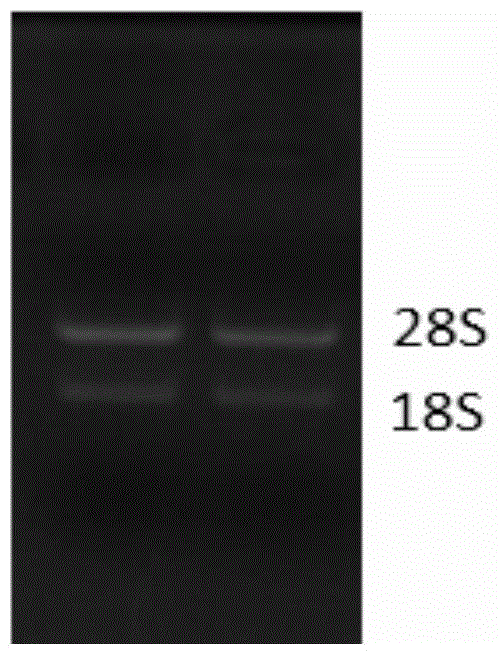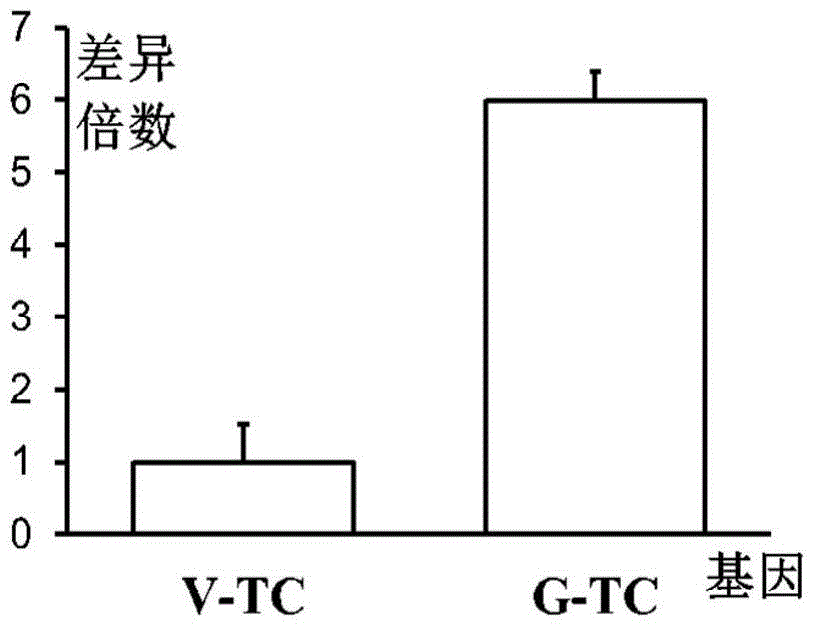Tetranychus cinnabarinus cytochrome p450 gene and application thereof
A technology of Tetranychus cinnabarinus and cytochrome, applied in the field of insect physiology and biology, to achieve the effect of reducing economic losses, reducing environmental problems, and good control effect
- Summary
- Abstract
- Description
- Claims
- Application Information
AI Technical Summary
Problems solved by technology
Method used
Image
Examples
Embodiment 1
[0025] Comparison of gene changes after Tetranychus cinnabarinus feeding on cowpea and cotton by expression profiling sequencing (gene screening)
[0026] The present invention firstly transfers Tetranychus cinnabarinus (this mite has been raised in the laboratory for more than 15 years without contacting any medicament) that feeds on cowpea seedlings raised indoors to cotton seedlings grown indoors. After feeding on cotton seedlings for 50 days, T. cinnabarinica whose hosts were cowpea seedlings (V-TC) and cotton seedlings (G-TC) were collected for total RNA extraction. Then BGI was commissioned to perform expression profiling sequencing on the extracted V-TC and G-TC total RNA. Finally, through the analysis of expression profile data, compared with V-TC, more than 500 differentially expressed genes were found in G-TC. At the same time, the obtained differential genes were compared and functionally annotated, and genes were classified according to different functions. Then,...
Embodiment 2
[0027] Example 2: Cloning the full length of the tcCYP1 gene
[0028] 1 Extraction of total RNA
[0029] The total RNA of Tetranychus cinnabarinus was extracted by the Trizol method (the operation steps were completely carried out in accordance with the instructions of the Trizol extraction of total RNA). The results of the extracted electropherograms are shown in figure 1 .
[0030] 2 cDNA first-strand synthesis.
[0031] The operation steps were carried out in accordance with the instructions of PrimeScript II 1st Strand cDNA Synthesis Kit (D6210A) of TAKARA Company.
[0032] 3-gene full-length PCR amplification
[0033] Primer5 software design specific primer sequence
[0034] TcCYP1-Forward: ATGTTGCTTCTTGATTACTTTAGTG
[0035] TcCYP1-Reverse: CGAAAAAATTTCCTTTTAA
[0036] The reagent composition of polymerase chain reaction is as follows:
[0037]
[0038]
[0039] The conditions for the polymerase chain reaction are as follows:
[0040]
[0041] 4 Purificati...
Embodiment 3
[0051] Example 3: Verification of gene differential expression
[0052] 1 Extraction of total RNA
[0053] The operation steps were carried out in full accordance with the instruction manual of Trizol extraction of total RNA.
[0054] 2 Synthesis of cDNA template
[0055] The operation steps completely refer to the TaKaRa PrimeScriptTM RT reagent Kit with gDNA Eraser kit
[0056] 3 Fluorescence quantitative PCR
[0057] Primer 3 software design quantitative primer specific sequence:
[0058] F-qtcCYP1:CGCCTTCGCAAATGATGCTT
[0059] R-qtcCYP1:TAACCGTCTGTGTTCACGCC
[0060] The system configuration is as follows:
[0061]
[0062] program:
[0063]
[0064] According to the CT value obtained from the qPCR results, the gene expression difference multiple was converted (using 2 -△△ct method), the results showed that compared with T. cinnabarinus that ate cowpea, the gene that ate cotton had more than 6-fold up-regulated expression, which was consistent with the express...
PUM
 Login to View More
Login to View More Abstract
Description
Claims
Application Information
 Login to View More
Login to View More - Generate Ideas
- Intellectual Property
- Life Sciences
- Materials
- Tech Scout
- Unparalleled Data Quality
- Higher Quality Content
- 60% Fewer Hallucinations
Browse by: Latest US Patents, China's latest patents, Technical Efficacy Thesaurus, Application Domain, Technology Topic, Popular Technical Reports.
© 2025 PatSnap. All rights reserved.Legal|Privacy policy|Modern Slavery Act Transparency Statement|Sitemap|About US| Contact US: help@patsnap.com



